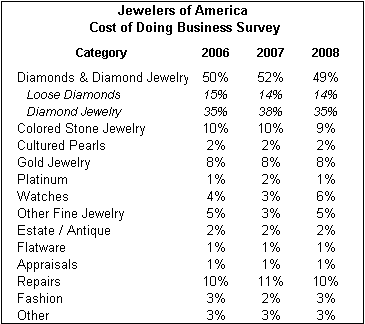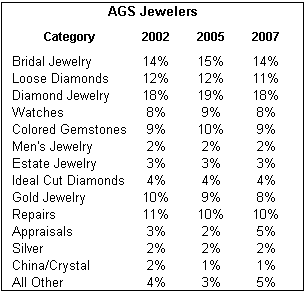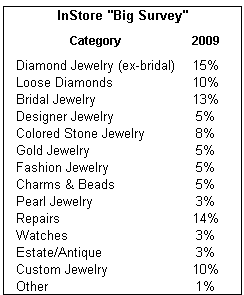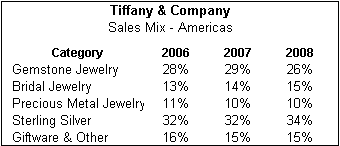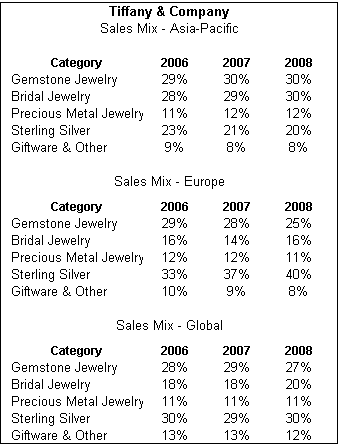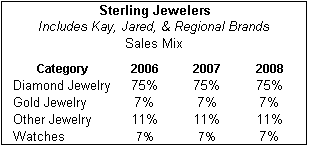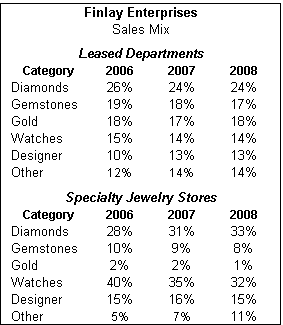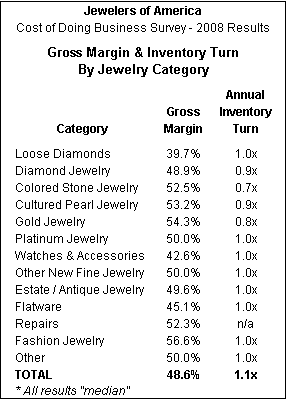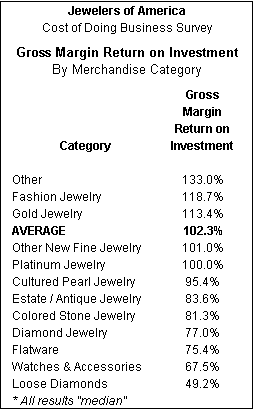IDEX Online Research: Diamonds Are a Jeweler’s Best Friend
November 26, 09
Diamonds are a jeweler’s best friend. That’s the conclusion of virtually every industry survey: diamonds and diamond jewelry are the largest selling category in a specialty jeweler’s store. Further, the second largest category – which varies, depending on the survey – doesn’t even come close to sales volume generated by diamonds and diamond jewelry.
While diamonds may be a jeweler’s best “sales” friend, they don’t have the sparkle in terms of sales growth, gross margin, or inventory turn. It would be difficult for a jeweler to do business without offering diamonds – these gemstones draw in consumers who want flash – but profits from diamonds are below average and price points are at a level that is higher than many consumers are willing to pay in a recessionary environment.
The good news: history tells us that, soon after an economic recovery, consumer spending tends to revert to near pre-recession levels. Thus, fueled by heavy industry promotions, we would expect to see diamonds and diamond jewelry regain their sparkle and luster with consumers.
Jewelers of America Survey Is Base Data
The Jewelers of America Cost of Doing Business survey has been compiling industry data since the 1980s, and it is the “granddaddy” of all surveys. The number of jewelers responding to the survey bounced back sharply this past year – largely due to a change in distribution of the questionnaires – and this has helped the credibility of the survey.
According to the Jewelers of America Cost of Doing Business Survey, 49 percent of a specialty jeweler’s sales are generated by loose diamonds or diamond jewelry. This level – roughly half of all specialty jewelers’ sales – has been consistent for many years. Further, product sales data from the Department of Commerce confirms that diamonds / diamond jewelry generate about half of the industry’s sales.
The second largest sales category for jewelers is repairs, which represent about 10 percent of sales. However, in terms of jewelry merchandise, the second largest jewelry goods category, according to the Jewelers of America, is colored gemstone jewelry, which represents about 9 percent of a typical jeweler’s sales. Gold jewelry – at about 8 percent of sales – is in third place.
The table below summarizes a typical American specialty jewelers’ sales by category, based on the most recent data (2006-2008) from the Jewelers of America Cost of Doing Business Survey.
|
|
AGS Survey Reflects Guild Jewelers’ Sales
The American Gem Society conducts a survey of its members – about 1,200 of America’s higher-end “guild” jewelers – every two or three years. Among guild jewelers, there are some significant differences from the industry average. For example, bridal sales represent up to 40 percent of a mass market jeweler’s sales, but this category is less than 20 percent of a typical AGS jeweler’s sales. On the other hand, AGS jewelers tend to sell more watches: this category generates almost 10 percent of a guild jeweler’s sales versus half of that level for the industry average. There are some other differences, too, as the table below summarizes.
|
|
InStore Magazine Initiates Its “Big Survey”
A relative newcomer to jewelry industry surveys is InStore Magazine, a publication that primarily targets the independent specialty jeweler. Every issue is filled with information about how this segment of specialty jewelers can compete against chains, multi-line jewelers, and others who sell jewelry.
For the second consecutive year, InStore has surveyed its readers, and its sample is large enough to provide credible information about independent specialty jewelers.
According to its survey, diamonds and diamond jewelry are about 25 percent of its readers’ sales. However, when bridal jewelry is added to that total – most bridal jewelry is diamond jewelry – nearly 40 percent of an InStore’s reader’s sales are generated by diamonds.
The table below summarizes sales by major jewelry category for InStore’s survey respondents.
|
|
Publicly Held Specialty Chains Report Limited Information about Sales Mix
Unfortunately, most of the publicly held chains report as little about their sales mix as the Securities & Exchange Commission rules will allow. As are result, there is far less information available on their sales mix versus smaller independent jewelers.
Guild Jewelers Have a Unique Merchandise Mix
Birks & Mayors, a guild jeweler, reports sales only by two segments: jewelry and watches. Birks & Mayors’ south Florida stores – Mayors Jewelers – have a reputation as being “the place” to buy a high end watch in their market. In addition to wealthy retirees in that market, much money streams into south Florida from Central and South America. Hence, the market for flashy high-end watches is probably greater in south Florida than in most other markets in the U.S.
While the typical jeweler in the U.S. generates between 5 percent and 10 percent of sales from watches, Birks & Mayors generates over 40 percent of its sales from timepieces (its name for “watches”), as the table below illustrates.
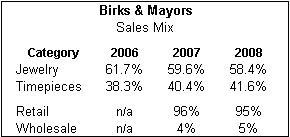 Source: Company reports |
Tiffany & Co., the world-renowned jeweler, reports its sales in categories that are most reflective of its business. Thus, those categories are unique to Tiffany. It is difficult to compare those categories with any other surveys. Tiffany also reports its sales by category segmented by geographic areas. Earlier in the decade, it segmented sales by major market, including a specific category for the U.S. Now, it includes sales in the U.S. market in a broader category called “the Americas.”
Based on a comparison of the two categorizations, it is clear that non-U.S. customers who live elsewhere in the Americas purchase more lower price-point merchandise. For example, in 2006, when data was presented both by “U.S. sales” and by “the Americas” sales, the average bridal ticket was $4,500 for U.S. customers. When the U.S. average ticket for bridal merchandise was amalgamated into “the Americas” average ticket, it dropped dramatically to $2,500. Further, there was a shift in the merchandise mix toward lower-end goods.
The table below summarizes Tiffany’s merchandise mix for the past three years for its stores in “the Americas.” In calendar 2008, Tiffany operated 76 stores in the U.S., six stores in Mexico, two stores in Canada and two stores in Brazil, for 86 stores. Worldwide, it operated 206 stores. The company’s stores in “the Americas” generated about 55 percent of corporate revenues in 2008, or just under $1.6 billion of total company sales of nearly $2.9 billion.
|
|
The table below summarizes Tiffany’s sales by other geographic regions. In the Asia-Pacific region, the company operated 57 stores in Japan and 39 units elsewhere in Asia-Pacific, 96 units. It also operated 24 stores in Europe. Tiffany’s stores in the Asia-Pacific region generated about 32 percent of corporate sales in 2008, while its European stores generated about 10 percent of sales. About 3 percent of corporate sales came from non-retail segments, primarily wholesale diamond sales.
|
|
Mass Market Jewelers Focus on Diamonds
Sterling Jewelers reports sales broadly by category. Sterling is a leader in the sales of diamond jewelry, a category it has been building primarily by using private label brands such as the Leo Diamond. Last year, diamond jewelry represented three-fourths of Sterling’s sales, far ahead of the industry average. The table below summarizes Sterling’s merchandise sales mix for the past three years.
|
|
Among the mass market jewelers, Zale reports its sales by “kiosk” versus “store” sales. This is not meaningful for merchandise comparison purposes, so this company’s results are not included in our research. However, based on management’s comments, we believe that diamond sales are very important to Zale and likely represent well above 50 percent of total corporate revenues. After all, Zale is known as The Diamond Store.
Finlay Enterprises reports its merchandise sales into broad categories and segments them between its leased departments and its “fine” jewelry stores (we’d characterize those stores as guild stores since they include Carlyle, Congress and Bailey Banks & Biddle).
As expected, the leased departments do not generate significant revenues from diamond jewelry, though Finlay has been focusing on building this merchandise segment. Because department stores are known as purveyors of “fashion,” the retail price points for their jewelry tend to be well below the industry average.
When shoppers buy jewelry at a department store, they are not willing to spend as much money as they might at their neighborhood specialty jeweler. As a result, diamond jewelry – a category with a relatively high average ticket – is not a popular item in department stores where Finlay operates its leased departments.
The table below summarizes Finlay’s merchandise mix by leased departments versus its fine jewelry stores.
|
|
Online Jeweler Blue Nile Focuses on Diamond Engagement Rings
Blue Nile is building a reputation among younger consumers as “the place” to buy a diamond engagement ring. As a result, its sales reflect this goal. Almost three-fourths of Blue Nile’s sales are generated from diamond engagement rings, as the table below illustrates.
|
|
Profitability by Merchandise Segment Varies Substantially
The Jewelers of America Cost of Doing Business Survey is the only in-depth research which attempts to measure critical financial factors in a jeweler’s business. These include gross margin by category, inventory turn by category, and, most importantly, gross margin return on investment (GMROI) by category. The results will be surprising to some jewelers, but for those who have any basic business acumen, they already know the answers.
As expected, the gross margin from loose diamonds is the lowest of any reportable merchandise category – just under 40 percent. Store-based jewelers are competing with online sellers of loose diamonds. Blue Nile, for example, generates a gross margin of about 21 percent, half that of a store-based jeweler. Clearly, Blue Nile sells diamonds for less.
Watches are another lower-margin category. It is no surprise: they are branded, and branded goods make it easy for shoppers to compare prices. As a result, there is much more price-based competition among branded goods than non-branded generic goods that are not easily comparable.
Interestingly, there is no category that stands out with higher-than-average margins. At one time, colored gemstone jewelry generated well above average margins. This category’s margins, along with pearl jewelry, are above average, but not as far above average as in the past.
Jewelers generally turn their owned inventory about once per year, far below the retail industry average of 3-4 turns per year. This low inventory turn is a detriment to obtaining adequate financing. Banks don’t want to be stuck with non-salable merchandise, and they typically want their lines of credit to be paid off for a minimum of thirty days each year. A one-time inventory turn does not meet banks’ criteria for “short-term” financing.
There are no surprises among the inventory numbers for specialty jewelers. No category has an unusually high inventory turn, though colored gemstone jewelry has an unusually low inventory turn.
The table below summarizes gross margin by merchandise category as well as inventory turn, based on data in the Jewelers of America Cost of Doing Business Survey.
|
|
The measure of GMROI – Gross Margin Return On Investment – is where “the rubber meets the road.” As the Jewelers of America Cost of Doing Business Survey explains it, “A good measure of inventory profitability is gross margin return on inventory (GMROI). It is calculated by dividing gross margin in dollars (“gross profit”) by average inventory value. GMROI will indicate whether an adequate gross margin is being earned compared with the investment in inventory required to generate those gross margin dollars.” (Edited slightly for emphasis and explanation.)
If you are looking for surprises, you’ll find them in the GMROI calculations. Diamonds – which are specialty jewelers’ most important sales category – generate among the lowest GMROI. Forget keystone markups – this category simply doesn’t generate the margin or the turn that is necessary for ongoing profitability for jewelers. We note that watches are also among the lowest GMROI of any category. Looking for the “hot” profit category? Gold jewelry, platinum jewelry, pearl jewelry, fashion jewelry and “other” are stand-out categories.
The table below summarizes GMROI by merchandise segment in order of importance.
|
|
